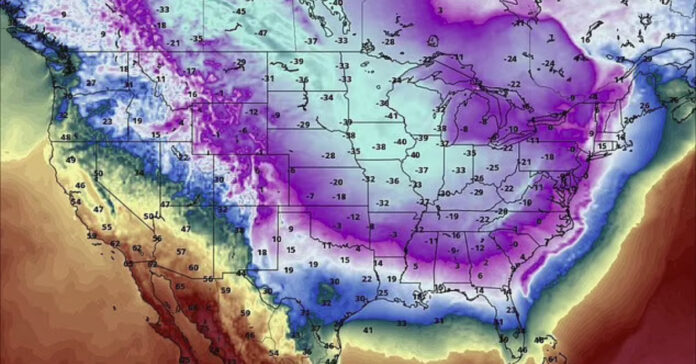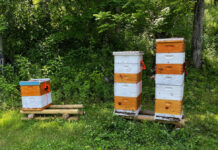
It looks like 2025 is starting off on a cold and snowy note. Not just near our mountain, but for two-thirds of the U.S. and much of Europe. Of course, it is January, the middle of winter, so perhaps we should expect wintry weather. But the National Weather Service expects this may be one of the coldest Januarys on record.
If you live in the Northwest, the Midwest, the Northeast, the Mid-Atlantic states and even down the East Coast to Florida, this is the time to prepare. While we don’t know exactly what will happen when, early indications are we could see snow and bitterly cold temperatures for a couple of weeks. And while it is too soon to be sure, early reports imply that the polar vortex could last at least a week.
I often think the ability to predict bad weather as much as ten days in advance does nothing but give people more time to worry. 50 years ago, we had two or three days warning, enough to run out and buy milk and bread but not enough to spend a week agonizing about it. Because winter cold could hit at almost any time from December through March, we were prepared.
Well, if any of you are unprepared, you now have a few days to get better prepared. Use them wisely.
If you are lucky enough to have a full pantry and a reliable heat source, be sure to check on any neighbors during a lengthy power outage or after a bad storm. Pay special attention to elderly and people with young children. If you don’t want to take someone into your home, volunteer to drive them to a warming center or contact local law enforcement who can often arrange transport.
Electrical Issues – Then and Now
For most of my life, a cold snap didn’t mean a shortage of electricity. Today, the danger of an electrical outage is high when temperatures plunge. This is not because of tree limbs or heavy snow, but because too many people rely on electricity to heat their homes during a cold snap. As a result, demand can exceed electrical generation capacity. As we saw in Texas in February 2021, when that happens, the utilities cut off large swaths of customers to keep the system from collapsing and potentially resulting in a grid-wide failure.
In Texas, the result of the utility’s inability to produce sufficient power was thousands of frozen pipes and 148 deaths. I don’t blame Texas; I blame the EPA for shutting down coal-powered electrical generation plants.
Texas was hit hard by cold weather, but another part of the problem is that their infrastructure is not designed to withstand cold weather. Many private companies shut down their refineries, chemical, and polymer plants on the gulf coast when cold weather approaches, but that’s not possible with utilities. The result is natural gas production and electrical generation might fail due to frozen pipes.
Relying on solar power doesn’t help because solar panels don’t produce power when they are covered with snow.
If the polar vortex rushes down to Florida, as some predict, we may see if they have learned any lessons from the debacle in Texas.
A Prepping Lesson
The most important lesson for preppers from 2021 is you need to have an alternate source of heat. Specifically, one that does not rely on electricity, natural gas, or other utilities.
A wood stove is best, in my opinion, followed by a kerosene heater and a propane heater. I rank propane the less desirable of the two because the propane heaters rapidly burn through fuel. People who were given Mr. Heater Gas Buddy heaters after Helene complained they lasted only three to six hours on a one-pound propane tank. Set on low, this heater will use four one-pound tanks a day to heat a room in your house, but it costs $19 to buy the four tanks at Walmart. You are better off to buy the larger tank and the contraption that will let you attach it to the heater. Once you have it on hand, you can run the heater for $4 a day.
To add insult to injury, heating one room is unlikely to keep your pipes from freezing. Better get several heaters or turn most of your water off and drain the pipes to keep them from freezing.
I’ve used a 23,000 BTU Kerosene heater that can heat a small house on about 4-gallons of kerosene a day, if set on high. I have 10 gallons on hand, so that will not last me long.
Both kerosene and propane heaters that have an open flame can put off a combustion smell. To me, the kerosene smell is worse.
Whatever alternative heater you select, make sure you have adequate ventilation to avoid carbon monoxide poisoning.
Other Preps
Last month, I recommended updating your car’s survival kit to include winter gear. We have already done so, but we also have a bag of insulated coveralls and extra food in the garage. If we are forced to drive during the extreme cold, we throw it in the car to give us some added protection.
I carry dry kindling as a matter of course, but I would consider throwing a few pieces of dry firewood in the back of the truck, just in case. With any luck, we’ll just stay home. I don’t mind driving in cold weather, but I prefer to stay off the road in the snow. In part, this is because our road is unplowed and quite steep. While this is a downside of living halfway up a mountain, we plan for it.
After getting caught a little under-prepared by underestimating the threat Helene posed, I went to the bank on Tuesday, deposited a check, and got $300 cash back. I also filled my vehicle’s gas tank and my only empty gas can, giving me a comfortable 45 gallons of gasoline on hand. Since I was already going out, my wife gave me a shopping list, and I did the grocery shopping. This time around, we won’t be running out of bananas, onions, celery, and other veggies for at least a week.
North versus South
My wife and I both grew up in the Northeast and went to college on campuses cold enough that the buildings were connected by tunnels. I also lived in the snowbelt for ten years after that. We know what a harsh winter is like. When we moved to the South, we were surprised to find that you could not buy kids’ winter boots in the stores. Why? Because they don’t get that much snow, so no one buys snow boots. My wife laughed at people who didn’t own winter coats while I laughed at people who would navigate snowy parking lots wearing crocs and shorts.
If you are reading this in New England, upstate New York, Chicago, Minnesota, the Dakotas, Idaho or somewhere else where it is cold all winter by design, trust me when I tell you, there are people in places like Texas and Florida who need these warnings. They have no idea what they could be in for.
For those of you who do not have snow tires, who lack long underwear, and who think a hoodie is all the outerwear you need when it gets cold, let me advise you to stay home when the temperature drops below 20°F. Don’t try to drive if there is even a dusting of snow. By all means, rush out and buy bread and milk beforehand, but also buy some canned soup, a tub of peanut butter and some crackers, and a box of Swiss Miss hot chocolate. And while you are out there, stock up on firewood if you have an indoor fireplace, even if you have to buy bundle wood at $7 per bundle. It may save your life.
Here’s another useful post:






